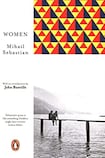
Sometimes the right combination of author and translator can create a magical alchemy that takes a work to a higher register. Romanian author Mihail Sebastian has had books published before in English, including a novel (The Accident) and his wartime journals, but it was only with the English publication in 2016 of his novel For Two Thousand Years that he gained the accolade he deserved of a wider readership.
That book’s success was due in no small part to the lucid, fluent translation by Philip Ó Ceallaigh – no slouch as a writer himself, with two award-winning collections of stories and another due shortly from Stinging Fly – which matched the loose discursiveness of Sebastian’s narrative. It is a minor masterpiece of voice, mood and emotion, quite aside from its insight into anti-Semitism in interwar Europe.
We’re now lucky enough to have another Sebastian/Ó Ceallaigh collaboration: four linked stories, first published in 1933, about the women in the life of a young Romanian student in France, Stefan Valeriu. And although it’s a short book, it adds up to a lot of women, especially in the first story, as the title suggests: Renée, Marthe, Odette.
Here Stefan is an exotic plaything for women (“un nouveau jeune homme!”), his fellow guests at a holiday resort. He has relationships of varying physicality with married women Renée Rey and Marthe Bonnard, without their husbands’ knowledge: “Monsieur Rey plays chess just as well as before and his handshake betrays no suspicion.”
The third, Odette, is the young, confident daughter of rich parents, who proves as much of a distraction to Stefan as he is to her. The story shows love, like life, to be cyclical: the sun rises again, trains depart again, and the women leave the resort again, just as Stefan will himself one day. The story, like For Two Thousand Years, has a scattered feel, as Sebastian sketches four main characters and several supporting ones – mainly cuckolds – in under 50 pages, but it fits the dreamy temporality of the plot.
Next comes Emilie – each story is named after its central character – who was a virgin when Stefan met her: “Why… I couldn’t tell you. Laziness or lack of imagination.” This cynicism curdles into something more vicious as he reflects on her “hefty … docile … ugly” qualities. A similar attention paid to the “ugly” body of one of his married lovers in the first story now looks like a pattern, but he “assures” us that, as far as Emilie is concerned, “you wouldn’t understand what sweetness her ugliness held”.
It’s far from clear whether Sebastian here is putting a beady eye on the male gaze or enacting it, but in any event in this story Stefan is a bystander, an accidental matchmaker between Emilie and another man.
Tragic grandeur
Perhaps, though, the unkindness in his descriptions is an effort to soften up the reader, as Emilie’s story manages to acquire a tragic grandeur, incorporating birth, marriage and death within its skimpy extent. That, together with the more traditional narrative arc here than in the first story, shows us the first signs of Sebastian’s larger plan: to show love from all angles, not just in subject but in structure. First close up, then at a distance.
And next, in the story Marie, at a sort of reverse angle: Stefan takes a further back seat, as the addressee of a letter written by a friend to whom he had recently, and unrequitedly, declared his love (her response: “I just think our wonderful friendship could have done without this accident”). And in a spicy bit of salt/wound knowhow, Marie goes on to explain her love for another man, Andrei.
“He occupied my existence so completely, filled it up as you’d furnish an abandoned house.” It may not be what Stefan wants to hear, but it’s beautifully done, and the female voice shows a subtlety that contrasts with the riper earlier stories.
By the time the last story, Arabela, comes around, Stefan is back at the heart, narrating his own love life. Paris, sketchily laid out in Emilie and Marie’s stories, is full and bright on the page here, both in the fabric of the city and the people: Stefan lives in a world of revolutionaries who write “incendiary publications read by exactly seventeen people, each ready to turn the world upside down”.
By now Stefan seems a different person, no longer the young lover but a man wearied a little by the life and love he’s been through since the first story, and the collection feels fully coherent by the end.
This edition is introduced in typically sharp-eyed fashion by John Banville, who reminds us that Sebastian survived the second World War only to be killed in 1945, aged 38, as he crossed the road to teach his first class. His death is a loss to literature as great as that of other under-celebrated Jewish writers of the era, such as Bruno Schulz and Jirí Weil.















